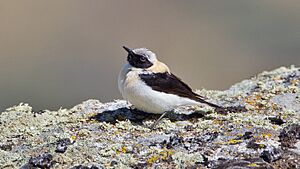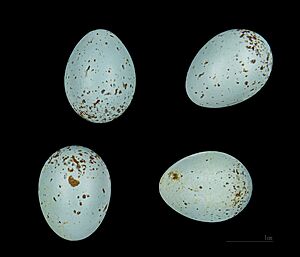Western black-eared wheatear facts for kids
Quick facts for kids Western black-eared wheatear |
|
|---|---|
 |
|
| male | |
| Conservation status | |
| Scientific classification | |
| Synonyms | |
|
Motacilla hispanica Linnaeus, 1758 |
The Western Black-eared Wheatear (Oenanthe hispanica) is a small, migratory bird. It belongs to a group of birds called wheatears. These birds used to be thought of as part of the thrush family. But now, scientists know they are actually Old World flycatchers. This means they are in the family Muscicapidae.
This bird is known for its striking looks. It travels long distances between its breeding grounds and where it spends the winter.
Contents
What Does This Bird Look Like?
The Western Black-eared Wheatear has different looks depending on if it's a male or female, and the time of year.
Male Wheatear's Colors
When it's time to breed, the male bird is quite colorful.
- Its forehead and the top of its head are white or almost white.
- The back part of its body (called the mantle) is a soft buff color.
- Its wings are darker, almost black.
- The belly and chest are white with a hint of buff.
- The lower back and most of the tail are bright white.
- A black "mask" goes from its ears to its beak.
- Some males have a black throat, while others have a white throat.
In autumn and winter, the male's colors change a bit. The head and back become more buff. The underparts also turn buff, including the throat for those with white throats. The tail feathers are mostly white, especially compared to another bird called the northern wheatear.
Female Wheatear's Appearance
The female Western Black-eared Wheatear is usually browner than the male. However, she still has the special white lower back. Her colors do not change as much throughout the year as the male's do.
How to Tell Them Apart: Western vs. Eastern
It can be tricky to tell the Western Black-eared Wheatear from its close relative, the eastern black-eared wheatear.
- Western males have more buff colors on their upper parts. This makes them look less sharply black and white.
- The black mask on Western males stops at the base of the beak. On Eastern males, it goes a little above the beak.
- Western males with black throats have less black on their throat and face. The black also ends more smoothly.
- Female Western Wheatears are a warmer brown color overall compared to Eastern females.
The Story Behind Its Name
Birds get their scientific names from scientists. These names often tell us something about the bird or where it was first found.
Early Discoveries
In 1743, a British scientist named George Edwards drew and described this bird. He called it "The Red or Russet-colour’d Wheat-Ear." He saw a bird from Gibraltar to make his drawing. Later, in 1758, the famous Swedish scientist Carl Linnaeus gave it the scientific name Motacilla hispanica. He put it in the same group as wagtails at first. The word hispanica means "Spanish" in Latin.
Modern Classification
Today, the Western Black-eared Wheatear is in the group (or genus) called Oenanthe. This name was given by a French bird expert, Louis Pierre Vieillot, in 1816. This bird is considered "monotypic," which means there are no different types (or subspecies) of it.
For a long time, the Western Black-eared Wheatear was thought to be the same species as the Eastern Black-eared Wheatear. But a study in 2019 looked at the birds' genetics. This study showed they were different enough to be called separate species.
What "Wheatear" Means
The name Oenanthe comes from old Ancient Greek words. Oinos means "wine" and anthos means "flower." This name refers to the northern wheatear returning to Greece when grapevines start to blossom.
The common name "Wheatear" might sound like "wheat" and "ear." But it actually comes from an old English phrase. It's a changed version of "white" and "arse." This refers to the bright white rump (the lower back area) that many wheatear birds have.



